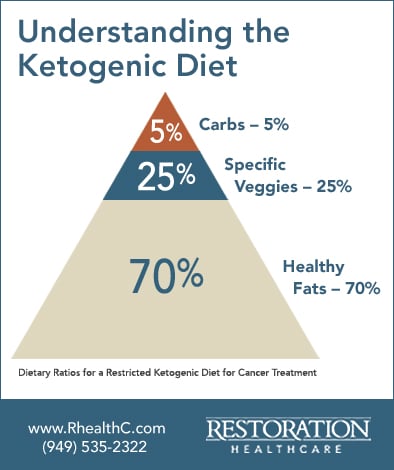Understanding the Ketogenic Diet

Originally intended for children with epilepsy, ketogenic diets are high in fats, low in carbohydrates and they feature a respectable amount of protein. Put simply, a typical meal would include copious amounts of fat (70 percent); protein with veggies (25 percent) and a smidgeon of carbs (5 percent.)
The purpose of a ketogenic diet program is to induce a metabolic change in which carbohydrate fuel — glucose — is switched to fat fuels, which are called ketones. This swap results in the body’s cells utilizing ketones instead of carbs to create energy.
When the body is deprived of glucose-building carbohydrates, fat is converted into ketone, which replaces the glucose as a source for energy. And when the body is in a state of ketosis, it actually prefers ketones over glucose. So instead of breaking down protein for energy, the body must turn to fat reserves for sustenance.
Here at Restoration Healthcare, we sometimes recommend a ketogenic diet to treat medical situations that include Lyme disease, diabetes, early onset of Alzheimer’s, and even cancer. The idea is to convert a patient’s metabolism to the “recovery and repair” mode — something that the typical American diet is incapable of doing.
Think of it as a modified Atkins diet, in that it encourages ingestion of vegetables, fats and proteins and shuns carbohydrates — especially those found in wheat, starch and some fruit. Like Atkins, the ketogenic diet forces the body to burn fats rather than carbs.
What is it exactly that comprises a ketogenic diet? And how does one plan ahead for such a diet, all the while keeping close tabs on what’s being consumed?
As we mentioned above, about 70 percent of your daily intake if placed on the ketogenic diet should be fats, with another 25 percent designated for protein and a scant 5 percent for carbs. If you can limit your net carb intake to 25 grams or less a day, so much the better.
And if you’re not certain what a net carb is, grab up a bag frozen veggies or a box of cereal. On the nutrition label, you’ll find the number of carbohydrates per serving (let’s say 12 grams). Now look for the amount of fiber per serving (let’s use two grams for this example). Simply subtract the fiber from the carbs to arrive at a net carb number, which in this case is two grams.
If we recommend this approach for you, you’ll want to stick to vegetables that are dark green in color (romaine instead of iceberg lettuce), as well as broccoli, asparagus, Brussels sprouts and cauliflower. And you’d be free to add fat to your protein of choice, like a slab of butter on your steak or a half chicken basted in olive oil.
Such a diet requires advanced planning, which means a grocery list that pays particular attention to the protein/fat/carb percentages. We also suggest you invest in getting used to using a ketogenic calculator in order to measure the nutritional needs required while on the diet. At Restoration Healthcare, we recommend the ketogenic calculators found here:
https://workoutcave.com/keto-calculator
http://keto-calculator.ankerl.com
As you can probably guess, our medical team is supportive of the ketogenic diet, especially for our patients living with Lyme disease. Come in and talk with us to determine whether this treatment — administered for a specific period of time and under our close supervision — is something that might interest you.
We can answer all your questions and point you in the direction of a beneficial health program.

